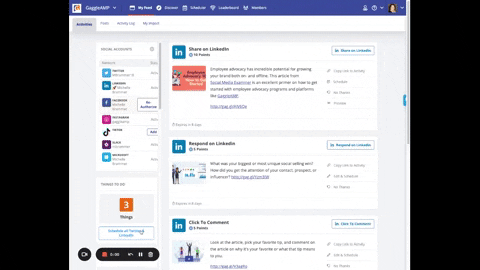Stakeholder Marketing: How to Engage Audiences Beyond Customers
As a marketer, you’ve carefully mapped a customer journey from awareness to conversion.
In reality? It’s not as linear as it appears on your sales funnel graphic. Customers always have interactions with your brand outside of the marketing messages you craft, shaping their perceptions.
These touchpoints might be in the form of a LinkedIn post or happy-hour comments from a peer or company employee. They might have read a review on a third-party site or interacted with your brand at a trade show. These interactions form a complex ecosystem of brand perceptions.
If your potential customers are already hearing about your brand from outside sources, why not work with stakeholders to amplify your reach and shape the narrative you want to tell?
What is Stakeholder Marketing?
Stakeholder marketing is a strategy for organizations to build and leverage relationships with internal and external shareholders outside of their target audience for the purpose of sharing value and expanding their brand reach.
By taking a shift in perspective to view stakeholders as content amplifiers and brand advocates, you can build an organic and sustainable ecosystem for your marketing efforts.
Types of Stakeholders and How to Map Them

You might be asking, who are my stakeholders? To determine which stakeholders to target in your stakeholder marketing strategy, you need to first do some analysis.
- User research. If you have existing research about customers’ buying journeys or have the resources to conduct some research, dig into whom leads spoke to and what steps or research they performed along their purchase journey.
- Journey map. A journey map is a great starting place to look at how a potential customer interacts with your brand. For this particular use, brainstorm what interactions a lead might have had outside of direct brand interactions. For instance, would they perform a Google search? Ask an industry group for recommendations? Walk past your office or retail location?
- Media search. Perform a news, search engine, and social media search for your brand’s name to find out who’s talking about you. Map out the top results, which organizations are talking about you, and whether it’s positive, negative, or neutral.
Once you’ve gathered this research, you have the basic information to start a stakeholder analysis. Write down all internal and external groups who may influence a potential customer’s journey at some point. Stakeholders fall into two categories: internal and external.
Internal Stakeholders

Internal stakeholders are employees or other close relationships that have a vested interest in the success of your company and the achievement of your goals. While it might seem obvious for internal teams to collaborate, more often than not they’re stuck in siloes.
For example, human resources may only focus on candidate outreach and internal communications despite the fact that company marketing affects employer brand and recruitment work. Marketing disciplines (social media, public relations, and marketing) may operate in siloes at your company and may not play well with sales.
Examples of internal shareholders include:
- Sales Team
- Human Resources/Recruitment
- Public Relations
- Board Members
- C-suite
However, just because a stakeholder is internal doesn’t mean they’ll collaborate willingly. Different departments, especially in matrixed enterprise companies, carry their own agendas and can guard their time and resources fiercely.
External Stakeholders

External stakeholders are people or groups who indirectly benefit from your success like a supplier or whose mission and interests intersect with yours. Don’t overlook existing customer relationships when considering stakeholders—engaged and loyal customers can be a powerful force for marketing.
Examples of internal shareholders:
- Existing customers
- Channel partners
- Manufacturers/suppliers
- Industry groups
- Investors
- Community groups (neighborhood association, cultural district, etc.)
One benefit of collaborating with external stakeholders is that their voice brings credibility as a person or entity outside of your organization. There’s much more power behind someone else saying that you have a fantastic product rather than you saying it.
The downside, of course, is that you can’t exercise as much control over what external stakeholders say about your brand. Negative reviews or stories can be hard to reverse, and praise needs to be earned. That’s where building relationships comes in.
Examples of Stakeholder Marketing and Employee Advocacy in Action
Stakeholder marketing can take many different forms depending on who you are and what your goals are. In the big picture, it’s a way to share your top messages with different audiences than you would normally reach.
Here are some examples of stakeholder marketing tactics:
- Asking stakeholders to share blog posts or social media content
- Enabling employees to share product updates, company news, or job opportunities
- Asking external stakeholders to include your subject matter experts as a speaker, guest blogger, or source for media inquiries
- Enabling board members, volunteers, members, or alumni to easily share about causes important to them
- Asking your stakeholders to share social content to garner interest around an event
- Gamifying employee advocacy with a way to track and reward employee brand advocacy
Need some inspiration? Find out how these companies use stakeholder marketing to get their message out.
Pivot3 Employee & Channel Partner Advocacy
Pivot3, an enterprise IT infrastructure company, depends on organic social media to help them compete with much larger competitors. Pivot3’s marketing department first started a program asking salespeople to copy, paste, and share social media updates.
While they saw some early success, they found low participation due to the manual process. Next, they adopted an employee advocacy platform to help them scale their efforts and expand the participation pool to general employees and company partners.
One particular success they saw was in sharing live-tweeted content at industry events like VMworld. During that event alone, Pivot3 reached more than 600,000 people with 569 click-throughs by making the content easy for partners and staff in attendance to share on the go.

JBC Recruitment Advocacy
As a national staffing agency, JBC depends on the visibility of its open positions for success. However, they knew that sharing from their corporate LinkedIn account has its limits.
Instead, they designed a program to list and enable its hundreds of employees to promote open positions on their own social media accounts.

Now, JBC employees have a way to see and easily share high-priority roles with their networks. The program has resulted in 7,600 clicks and 8,200 social interactions with an estimated earned media value of $73,000 in one year alone.
Its employees have also enjoyed the benefit of more visibility and engagement on their own profiles—the approximately 100 employees who are active in the program have added over 127,000 new social media connections while participating.
How To Build a Stakeholder Marketing Program From Scratch
Building a stakeholder marketing program takes research, thoughtfulness, and consistency. Let’s take a look at how to do it.
Complete Your Stakeholder Analysis
Once you’ve completed your stakeholder research to determine who may be influencing your buyer journey, prioritize stakeholder groups to target.
These should be a combination of the most influential and the most likely to collaborate with you. For instance, a governmental group may be an important stakeholder but may be restricted in terms of what content they can share. Identify groups where you already have an internal contact or strong connection.
Determine Your Approach to Stakeholder Marketing
Depending on your industry, company, and goals, there are several approaches to stakeholder marketing for you to consider.
- An exchange relationship is one where two groups agree to collaborate with an expectation of an exchange of benefits—also known as quid pro quo
- Instrumental stakeholder theory is the concept that managing stakeholders will result in achieving business goals. In this approach, you will set and closely measure your performance against business objectives.
- Normative stakeholder theory is the concept that stakeholder relationships have inherent value and that strong relationships are the end goal

If you operate in a metrics-driven business, you’ll likely want to take an instrumental stakeholder approach so you can demonstrate the value to your bosses. In a nonprofit organization, a normative stakeholder approach might be more appropriate. An exchange relationship is heavily prevalent in B2B marketing, especially in software-as-a-service.
Stakeholder Marketing KPIs
No matter your approach, you’ll want to identify some KPIs for stakeholder marketing, even if just for internal analysis. Examples of KPIs and activities tracked could include:
- Meetings
- Guest speaker/interview opportunities
- Social shares
- Social interactions
- Potential impressions
Resources for a Stakeholder Marketing Program
For a stakeholder marketing program to be successful, you need to plan for resources to build and maintain stakeholder relationships and measure program performance. These resources could include:
- Staff time to manage stakeholder relations
- An advocacy platform (such as GaggleAMP) to manage engagement requests and metrics
Take Time To Understand Your Stakeholders’ Motivations
Before you can approach stakeholders to ask for participation, you need to learn their purpose, motivation, and needs. Relationship-building won’t work unless you take the time to understand your stakeholders’ needs and help them fill them.
For instance, if you want to ask your sales team to amplify content for you, you might want to present them with stats that salespeople who use social selling are 51% more likely to hit their sales targets.

To ask a local community group to share your content, you may want to appeal to a shared mission or use exchange relationships to help them achieve goals with your employees such as fulfilling volunteer needs or raising funds.
Build Stakeholder Relationships
Relationships can’t be one-sided. Use these steps to build sustainable relationships across your organization:
-
Research to find the best contact. Ask for an introduction or try to find the best contact if you don’t have an existing connection.
-
Set an initial meeting with the stakeholder. During your first meeting (either virtual or in-person), listen first. Find out their goals, challenges, and opportunities to see where you intersect and what problems you can help solve for then. Share about your own goals second if at all, and don’t forget to follow up with a thank-you note.
-
Solve a problem for them. Find a quick way to help your stakeholder solve a problem. This could be as simple as making an introduction, recommending a tool, or sharing an opportunity with your network.
-
Ask for participation in your stakeholder marketing program. This ask could take place over email or in a subsequent meeting. Be sure to lay out how you envision your partnership working and what your expectations are.
-
Move forward. If the stakeholder wants to move forward, work on onboarding them to your stakeholder marketing process. If they decline participation, ask why and if what it would take for you to collaborate more closely in the future.
-
Stay in communication. Regardless of how the stakeholder responds, stay in contact. Some relationships take years to develop. Subscribe to your partners’ news and updates and set a reminder for yourself to check in with them frequently. Ask what’s going well and what’s not.
Create an Infrastructure for Success
Last, create an infrastructure for sharing content that will make it easy for participants to share content. Consider a content calendar or an employee advocacy platform to house all of your content and messages in one place. Plan ways to incentivize and reward stakeholders for collaborating with you.

Tools like GaggleAMP make it easy to curate content and place it in a digestible format that is easy for the end user to take action on, often in just one click. If you’re curious to learn more about how employee advocacy can help you in your stakeholder marketing efforts, schedule a demo with us and we’d be happy to discuss if this is a good solution for you.
Stakeholder Marketing: Strong Relationships Bring Stronger Performance
Think of stakeholder relations like brand-building: it’s a marathon, not a sprint. The more shares and interactions that your audience sees, the more likely they’ll be to purchase when the time is right.
Be consistent and intentional when working with stakeholders. Building awareness takes time, but the reward will be brand equity that’s much stronger than any single campaign.










